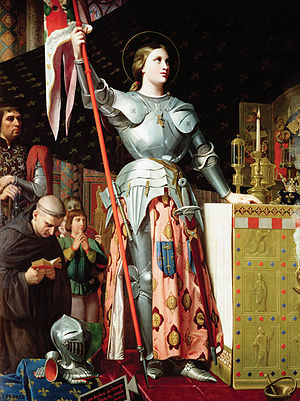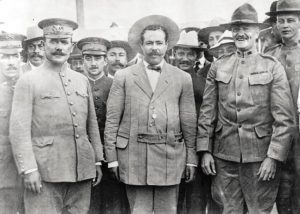Imagine yourself as a child, and imagine being able to hear the voices of the divine, the voices of angels such as Michael the Archangel. Imagine that every time you heard these voices you would see a bright light and you would feel a sense of security. Now imagine that your country had been invaded by those you had been at war with, and these voices came to you and tasked you with the mission to drive that enemy from your land. That was what life was like for young Joan of Arc. She heard the voices of the divine and accepted the challenge to drive out the English from France and to restore her country to what it once was. It was in 1429 when France came face to face with Joan, a young girl, just seventeen years old claiming to hear the voices of angels. Even so, the French knew of her coming because it had been prophesied before she was born, that “France would be ruined by a woman and restored by a virgin from the oak forest of Lorraine.”1

Joan of Arc, born around January of 1412, claimed early in her life that she was divinely inspired to help her country of France in the wake of the political and military turmoil facing her land. When she was in her early teens, she had witnessed a light, soon followed by voices that would speak to Joan with mild commands, “Be good” and “Go to church often.” She had said it was St. Michael who had spoken to her, but he was also accompanied by many angels as well, one of which was St. Gabriel. As she continued to listen to the voices of the divine, she came to realize her purpose, and that purpose was to save her people of France from their enemies. It was 1429 when Joan of Arc heard the voices telling her that it was time to begin her mission, the mission that they had been preparing her for.2
The Hundred Years’ War was a war between the two kingdoms of England and France. It lasted actually for 116 years, beginning in May 1337, and lasting until 1453. The war began when King Edward III of England, the grandson of French monarch Philip IV the Fair, claimed the French throne when the French king Charles IV died without a male heir to the throne.3 Throughout the war, the English had dominated and overpowered France, winning significant battles, such as the Battle of Crecy, the Battle of Agincourt, and the Battle of Poitiers. It was because of these battles and many other victories for England that many believed that the ultimate winner would be the English, and because most of the battles were fought on French territory, France was faced with a destroyed and battered country.

Even so, Joan of Arc was afraid at the enormity of what God was asking her to do. Yet she met His commands with determination and vigor. Joan dressed in male armor and cut her hair as a fallback so that none would be able to tell she was a woman and deny her the opportunity to fight and carry out her mission in the war. With this she took up the sword gifted to her by the angels and began her trek to meet the Dauphin, the yet-to-be-crowned King Charles. Once she came face to face with the Dauphin Charles, Joan of Arc was not immediately recognized as a leader, but she had told the Dauphin that she was sent to him by the voices of God to drive away the English soldiers. Ultimately, she convinced him to let her join the war. The Dauphin soon sent Joan to the Siege of Orleans (October 1428-May 1429).When she arrived, she raised the morale of the troops, allowing the French soldiers to break the siege only nine days later. Soon after, Joan and the French troops went on to take over several English strongholds, and because of the break in the siege and the victories afterward, it allowed the Dauphin Charles VII to march to Reims for his coronation. The siege was the first major victory for the French and the first victory for Joan as well. After the Siege of Orleans, Joan was recognized by King Charles VII as a leader. Joan went on to lead more troops, gaining more victories for France, finally turning the tide of the war.4

That all came to an end, however, when Joan of Arc was captured at Compiegne in May 1430. Upon her capture by English forces, Joan was accused of heresy and witchcraft. On January 9, 1431, her heresy trials began. Joan of Arc had six public examinations and nine private examinations in total. At the end of the trial, the judges composed The Twelve Articles of Accusation, which were the charges accusing her of hearing the voices of the divine and of dressing in men’s clothing, all confirmed by Joan of Arc herself. At the end of the trial, the church’s officials agreed that Joan’s actions and words were evil. They began their final sentence, and Joan agreed to obey all of the rulings made by the Church. She was welcomed back into the Church, but condemned to solitary penance in prison, so she could never commit another crime again. Despite agreeing to begin wearing female clothing again, four days after her sentence, Joan of Arc was seen in prison wearing male clothing, defying the agreed terms of the Church. Soon Bishop Cauchon and seven judges went to Joan of Arc’s cell and questioned her over her wearing men’s clothing. Upon arriving, the Bishop asked why she began wearing men’s clothing again, and she stated, “I had done this on my own free will. Nobody has forced me; I prefer the apparel of a man to that of a woman.”5 When asked why she had done this, she stated that it was more proper to wear men’s clothing than women’s because she was surrounded by men. She also stated that in her time spent in the prison she had been molested by the English when she was wearing women’s attire. The Bishop then asked if she had been hearing the voices of saints again, and when she answered yes, he asked about what they had told her. Joan of Arc had told the Bishop Cauchon that she had endangered her soul by recanting and that she was being condemned because she was trying to save her life. Joan also told him that if God did not want her to recant then she would listen to His word. With this the Bishop stated that she was a “relapsed heretic,” and that the church would have to take legal measures by proceeding “according to law and reason.”6 Joan was charged with relapsing into heresy on May 28,1431, because Joan of Arc had ignored the Church and admitted to hearing the voices of saints and started re-wearing men’s clothing. She was then sentenced to death, to be burned at the stake two days later, on May 30.7

During and after Joan of Arc’s trial, the French forces became timid and soft, but ultimately won the war in 1453. After the war, King Charles VII ordered a review of Joan of Arc’s trial, even though the Roman Catholic Church did not formally begin the canonization process till 1869 and even then was not declared a saint for another fifty years.8 France celebrated and recognized Joan as a national hero because Joan of Arc fulfilled the prophecy that was foretold, listened to the premonitions she received from God, and never strayed from her beliefs. The French believe she was a key factor in the war because she came to France’s aid when they were at their breaking point. Joan of Arc broke the Siege of Orleans and pushed the English back, allowing France to reclaim what they had lost. She is a hero not only of France, but she is a representation of courage and independence and to this day continue to celebrate her life and her legacy.9
- Soren Bie, “Prophecies,” Joan of Arc (Jeanne D’Arc) 1412 – 1431, 9 July 2017, www.jeanne-darc.info/biography/prophecies/. ↵
- Kathryn Harrison, Joan Of Arc: A Life Transfigured (New York: Doubleday, 2014) 1, 17-20. ↵
- World History Encyclopedia, 2011, s.v. “The Hundred Years’ War,” by Alfred J. Andrea. ↵
- Julien Thery “How Joan of Arc Turned the Tide in the Hundred Years’ War,” National Geographic, April 13, 2017, https://www.nationalgeographic.com/archaeology-and-history/magazine/2017/03-04/joan-of-arc-warrior-heretic-saint-martyr/. ↵
- Julien Thery, “How Joan of Arc Turned the Tide in the Hundred Years’ War,” National Geographic, April 13, 2017, https://www.nationalgeographic.com/archaeology-and-history/magazine/2017/03-04/joan-of-arc-warrior-heretic-saint-martyr/. ↵
- Julien Thery “How Joan of Arc Turned the Tide in the Hundred Years’ War,” National Geographic, April 13, 2017, https://www.nationalgeographic.com/archaeology-and-history/magazine/2017/03-04/joan-of-arc-warrior-heretic-saint-martyr/. ↵
- Craig Taylor, Joan of Arc: La Pucelle (New York: Manchester University Press, 2006), 205, 207, 216, 220, 222. ↵
- Mary Gordon, Joan of Arc (New York: Lipper/Viking, 2000), 166. ↵
- Julien Thery “How Joan of Arc Turned the Tide in the Hundred Years’ War,” National Geographic, April 13, 2017, https://www.nationalgeographic.com/archaeology-and-history/magazine/2017/03-04/joan-of-arc-warrior-heretic-saint-martyr/. ↵



40 comments
Antoinette Johnson
I’m amazed at Joan’s faith and willingness not to stray from her beliefs. She decided to take a stand fight for the country in the name of the divine. Joan of Arc is key figure for women. She fought independently and did not let her gender stop her from doing what was right. It is sad that the church condemned her for dressing like a man and hearing the spirits of the divine. She was not harming anyone and was defending her country and actually turned the tides of the war in the French’s favor. She deserved better without her the French would of lost to the English.
Micaela Cruz
The story of Joan of Arc has always been one full of courage and perseverance. The introduction paragraph was enjoyable to read as it caught my attention and kept m interested in wanting to keep reading this article. It was brave of her to step up and take France’s position into her hands and save her country and believe in the words she was hearing from the saints. What I admire about Joan of Arc is how she did not question the destiny given to her at such a young age, she obeyed what she was told until her death.
Michael Hinojosa
This article is definitely great at grabbing the readers attention and the way the information is presented and how it follows the story/flow of Joan the Arc and captured her character very well too! Information wise there was a lot in this article that I didn’t know prior so not only was it very entertaining but it was very informative as well!
Martina Rodriguez
While I’m familiar with Joan of Arc, I had not know that she was literally prophesied to do all that she would in her youth. Did the Dauphin think that Joan was a man? Do we know if she changed her name or if she went by a man named Joan? I had never heard of the Twelve Trials of Examination before, but now I’m curious to read what exactly they charged her with. Hard to read all the injustice that the Church put one of their own saints through…
Sebastian Carnero
One of the most famous and interesting characters. She had one very hard task to accomplish. Not only bring victory to a country who is loosing but doing so while facing against the treatment women had at that time. I admired her determination in battle, and how she kept what she believed in, facing the Church and their warnings keeping men’s clothes and confirming the messages.
Valeria Perez
Joan of Arc is one of my favorite saints! I find it incredible that a seventeen-year-old left her home in order to lead an army between the two most powerful countries at the time! It must have been hard for her to be accused of heresy and witchcraft when she knew that it was the voices of angels. This was a great article!
Peter Coons
Joan of Arc is a titular character in history. For only having been in the right place at the right time, a women with no military training was able to organize the French forces at Orleans to repel a siege in only nine days. If I was at that battle, I too would assume she had some divine gift. No average person would be able to do that, and whether the voices she heard were divine or she was simply mad but was able to channel it into combat prowess, we may never know. This article does a fine job of posing that question in my opinion.
Dylan Sanchez
My knowledge of Joan of Arcadia was very limited prior to reading this article. She was brave and knew to follow the will of God despite going against the norms of society and the church. It’s so shocking that the Church would do this to her. She fought for no evil and had good morals and reasoning. Atleast the people of today can recognize her as a fantastic hero.
Nathan Alba
I had a somewhat okay past knowledge of Joan of Arc, but this article went into great detail. I never knew the amount of examinations that she went through before being charged, I honestly thought they just captured her and burned her at the stake. I also did not know there was a prophecy about her saving France. It is nice to know that although she was tried and executed that she didn’t die in vein.
Nathalie Herrera
This article has a great hook that flows very well within the story of Joan of Arc. I have not had any prior knowledge of this story before so it was interesting to read that “divine voices” would change the lives and history of France. It is remarkable to read how she took matters into her own hands to help France. This article is fascinating to me because Joan is a woman, and many times you don’t hear a lot stories of women making courageous acts or being viewed as heroes, especially during that time period. Overall, great read!